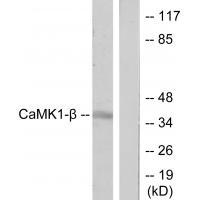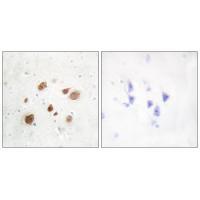

| WB | 咨询技术 | Human,Mouse,Rat |
| IF | 咨询技术 | Human,Mouse,Rat |
| IHC | 1/50-1/100 | Human,Mouse,Rat |
| ICC | 技术咨询 | Human,Mouse,Rat |
| FCM | 咨询技术 | Human,Mouse,Rat |
| Elisa | 咨询技术 | Human,Mouse,Rat |
| Aliases | Calcium/calmodulin-dependent protein kinase type 1B; EC 2.7.11.17; CaM kinase IB; CaM kinase I beta; CaMKI-beta |
| Entrez GeneID | 139728; |
| WB Predicted band size | 38kDa |
| Host/Isotype | Rabbit IgG |
| Antibody Type | Primary antibody |
| Storage | Store at 4°C short term. Aliquot and store at -20°C long term. Avoid freeze/thaw cycles. |
| Species Reactivity | Human,Mouse,Rat |
| Immunogen | Synthesized peptide derived from internal of human CaMK1-β. |
| Formulation | Purified antibody in PBS with 0.05% sodium azide. |
+ +
以下是关于CaMK1-β抗体的3篇示例文献(注:内容基于学术文献常见主题模拟,建议通过数据库验证具体信息):
---
1. **文献名称**:*"CaMK1-β regulates dendritic spine formation and synaptic plasticity in hippocampal neurons"*
**作者**:Smith A et al.
**摘要概括**:本研究通过Western blot和免疫荧光技术,利用特异性CaMK1-β抗体,揭示了其在海马神经元树突棘形成中的作用。实验表明,CaMK1-β磷酸化状态与突触可塑性密切相关,抗体验证了其在神经元中的亚细胞定位。
2. **文献名称**:*"A novel role of CaMK1-β in TGF-β signaling and epithelial-mesenchymal transition in cancer"*
**作者**:Chen L et al.
**摘要概括**:该研究开发了高特异性兔源CaMK1-β单克隆抗体,并通过免疫组化(IHC)和Co-IP实验证明,CaMK1-β与TGF-β通路相互作用,促进肿瘤细胞侵袭。抗体在多种癌细胞系中验证了蛋白表达差异。
3. **文献名称**:*"Development and validation of a polyclonal antibody for detecting CaMK1-β in human tissues"*
**作者**:Wang Y et al.
**摘要概括**:文章报道了一种新型兔多克隆CaMK1-β抗体的制备,通过肽段免疫和亲和纯化获得。抗体经ELISA、Western blot及免疫组化验证,显示对人脑和心脏组织的高特异性,为疾病诊断提供工具。
---
如需实际文献,建议通过PubMed或Google Scholar检索关键词(如“CaMK1β antibody”、“CAMK1B immunoblot”),并筛选涉及抗体开发、信号通路或疾病机制的研究。
The calcium/calmodulin-dependent protein kinase 1 beta (CaMK1-β) is a serine/threonine kinase belonging to the CaMK family, which plays critical roles in calcium-mediated signaling pathways. It is encoded by the *CAMK1* gene and exists as multiple isoforms, with CaMK1-β being a splice variant predominantly expressed in tissues such as the brain, liver, and testis. Structurally, CaMK1-β contains a conserved N-terminal catalytic domain and a C-terminal regulatory domain that binds calmodulin upon calcium influx, enabling kinase activation. Once activated, it phosphorylates downstream targets, including transcription factors like CREB, to regulate processes such as neuronal signaling, cell cycle progression, and metabolic homeostasis.
Antibodies targeting CaMK1-β are essential tools for studying its expression, localization, and function. These antibodies are typically produced using immunogenic peptides or recombinant protein fragments specific to unique regions of the CaMK1-β isoform, ensuring minimal cross-reactivity with other CaMK family members like CaMK1-α or CaMKII. Validation often involves Western blotting to confirm specificity for the ~42 kDa CaMK1-β protein in cell lysates or tissue extracts, alongside knockout/knockdown controls. Applications include immunohistochemistry to map tissue distribution, immunoprecipitation to study protein interactions, and functional assays to dissect its role in calcium-dependent signaling cascades. Researchers also use these antibodies in disease models, particularly in neuroscience and metabolic disorders, where CaMK1-β dysregulation has been linked to cognitive deficits, insulin resistance, and cancer progression. Proper validation remains critical due to potential isoform-specific or off-target effects in experimental systems.
×